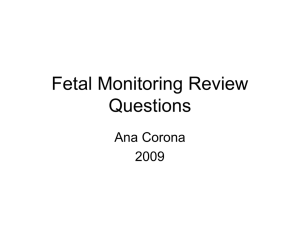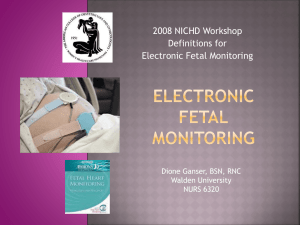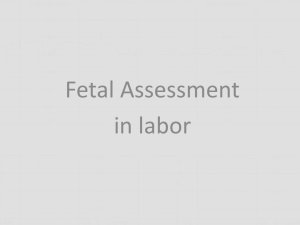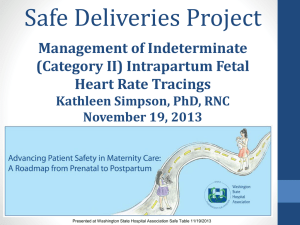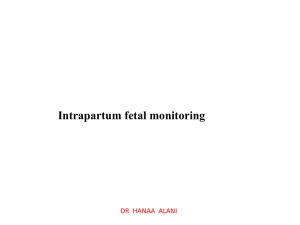Partograph-And-CTG-Intrapartum-Fetal-Monitoring
advertisement
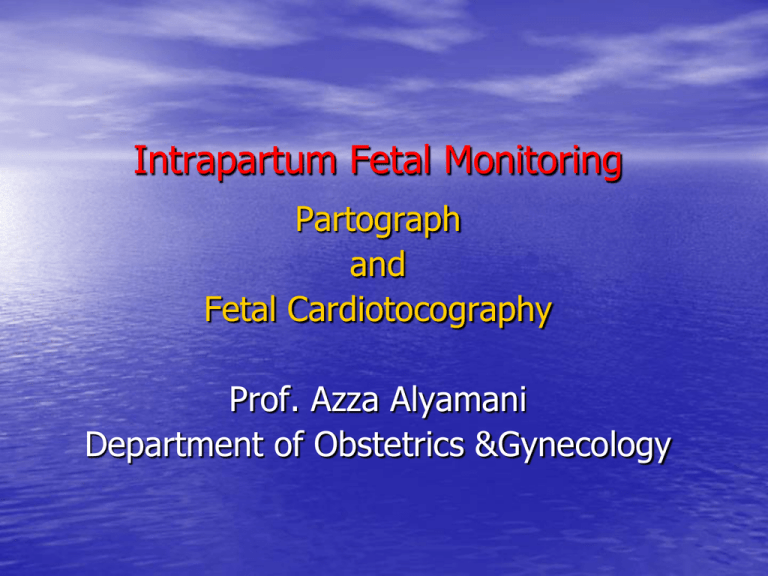
Intrapartum Fetal Monitoring
Partograph
and
Fetal Cardiotocography
Prof. Azza Alyamani
Department of Obstetrics &Gynecology
Aims of the presentation :
1. Be able to interpret routine data collected in
labor.
2. Be confident to interpret a partogram and
formulate a management plan based on the
patterns observed.
3. Understand fetal response in labor.
4. Be able to interpret fetal monitoring .
5. Be familial of normal and abnormal fetal CTG
traces.
Partogram
Definition:
it is graphical record of key data of labor progress
with both maternal and fetal data entered against
time .
it is the process by which normal and abnormal
progress of labor and also fetal response in labor
can be defined.
Importance :
It allows an instant visual assessment of the rate
Cervical dilatation and comparison with an expected
Norm , so that slow progress can be recognized
Earl and appropriate actions taken to correct it
Where possible.
Components
Part 1 : Fetal condition
a. Fetal heart rate.
b. The condition of the membranes and
liquor amnonii.
c. Moulding and caput formation.
Part 2 : Progress of labor ( Cervicogram ):
* it is a graphic representation of cervical
dilatation and descent of the presenting part .
* it is an essential part of the partogram .
* it offer the chance of early detection of slow
progress of labor.
* first ,we set an alert line at 1cm/h. for the active
phase dilatation to represent the ideal progress.
then ,we set an action line 2-4h.later to the
right of the alert line.
if the marks (plots) of progress falls beyond the
action line , the progress of labor is slow and
the cause of this should be sought and
corrected if possible or the decision
of cesarean section is
considered.
the cervicogram
Friedman′s Division of Labor :
he divided the first stage of labor into:
latent phase and active phases.
then , he
3 parts :
*
*
*
divided the active phase further into
acceleration phase.
phase of maximum slope and
deceleration phase.
Friedman’ s Division of labor
Uterine contractions :
Efficient powers ( good uterine contractions) are at
the center of Efficient labor bec:
* it cause cervical dilatation in the 1st stage , and
* rotation & descent in the 2nd stage.
efficient uterine contractions should be :
3-4 contractions in the 10 minutes ,each lasts 45-60 sec
with amplitute of at least 50 mmHg.
Part 3 : Maternal condition
Assessment of maternal condition
by monitoring :
regularly
* vital signs; temperature , pulse and bl.P
* drugs ; oxytocin ,analgesics ,IV fluids ect..
* investigations as urine analysis for protein and
acetone and volume.
Management of labor
using the partogram
Normal Progress of Labor
* latent phase : 8 hours or less .
* active phase : progress of the cervical dilatation
remains on the alert line or between the alert and
the action lines ( 1cm/hour ).
small doses of oxytocin or/and ARM may be
needed for active management of labor.
* second stage : reseanable rotation and descent of
the presenting part within 1 h. or less .
Abnormal (poor) Progress of Labor
a. Prolonged Latent Phase:
if extends 12 h (20h), in PG or 8h (14), in MG.
b. Primary dysfunctional ( prolonged ) labor :
slow cervical dilatation or poor descent .
c. secondary arrest ( obstructed ) labor:
of cervical dilatation in the 1st stage usually in
the deceleration phase or arrest of the descent
of the presenting part in the 2nd stage.
1=
2=
3=
5=
6=
Prolonged latent phase.
primary dysfunctional labor ( protracted cervical dilatation).
primary dysfunctional labor ( protracted descent ).
secondary arrest of cervical dilatation.
secondary arrest of descent.
Electronic Fetal Heart Rate
Monitoring
(EFM)
Electronic fetal heart monitoring {EFM}:
developed in the 1960s.
is achieved by either :
* internal or direct monitoring ,
by applying a bipolar electrode to the skin of the
fetal scalp ,the cervix has to be dilated and
membranes ruptured.
* external or indirect monitoring.
by using ultrasound ,usually by ;
External toco dynamo metry with a pressure
transducer placed on the uterus.
Indications for EFM
* low risk women with;
normal RHR on auscultation , no meconium
staining liquor and normal progress of labor
are extremely unlikely to deliver an
asphyxiated infants.
Admission test :
initial 20 minutes EFM screen in early labor is
enough to predict the likelihood of subsequent
fetal hypoxia.
* high risk women;
Maternal disorders:
• hypertensive diseases.
• diabetes mellitus.
• renal diseases.
• cardiac diseases.
• APH.
• RH isoimmunization.
Labor complications :
• dysfunctional labor ( slow progress).
• oxytocin augmentation or induction .
• preterm labor.
• VBAC.
Fetal complications :
• IUGR.
• previous SB.
• meconium staining.
• Post term pregnancy.
• abnormal FHR on auscultation.
• twins.
Fetal Heart Rate Patterns
A. Baseline FHR :
* tachycardia.
* bradycardia.
* variability.
B. Periodic FHR :
* Accelerations.
* decelerations.
• early
• variable
• late
• prolonged
• mixed
• sinusoidal
Baseline FHR:
* It is the rate recorded in between uterine
contractions.
* Normally 110 – 150 bpm.
* usually assessed over 15 minute interval
during labor.
Baseline tachycardia
* It is a FHR above 150 - 160 bpm.
* causes :
• Fetal hypoxia.
• Maternal or Fetal infection.
• Drugs as ritodrine and atropine.
• Maternal hyperthyrodism.
• maternal dehydration.
• Fetal anemia .
• Fetal cardiac arhythmias.
Baseline tachycardia
Baseline bradycardia
* It is a FHR less than 90 -110 bpm.
* It may be mild ( 90 -110 bpm. ) or
severe ( < 90 bpm. ).
* persistent mild fetal bradycardia is usually
benign. While severe bradycardia caused by
fetal congenital heart block.
Baseline bradycardia
Variability
* baseline or beat - to -beat variability is
controlled by the balance between the
sympathetic and parasympathetic nervous
control of the heart.
* normal variability is 5 – 25 bpm.
* it is reduced < 5 bpm. in :
• fetal hypoxia.
• physiological during fetal sleep cycles.
• drugs as ;dethadine ,barbiturates and
atropine.
normal beat to beat variability
Reduced beat to beat variability
Poor or absent variability
Periodic FHR
periodic changes in the FHR may be either :
A. Accelerations :
* is associated with ;
• fetal movements.
• uterine contractions.
* are considered benign and its presence
indicates a well oxygenated fetus.
normal FHR accelerations associated with fetal
movements ( reactive NST )
normal FHR accelerations with uterine
contractions
B. decelerations :
classically 3 well defined decelerations
are described ; early ,variable and late.
1. Early deceleration :
• this deceleration have a uniform shape ( bell),
starts early in the contraction and mirrors it.
• the magnitude of the deceleration is <40bpm.
• cause : head compression
mediated by vagal reflex.
• it occurs during the active phase , they are
benign .
early deceleration
2.Variable deceleration :
• it is the most common deceleration pattern.
• it appears as abrupt fall and return in FHR,
preceded and followed by small
accelerations ( shoulders).
• they are variable in shape V ,U or W shape ,
duration and timing.
• the magnitude is usually 50-80 bpm.
• cause : cord compression.
if it persists fetal hypoxia occurs.
• mild variable deceleration ( last < 30 sec.) is benign.
moderate (last 30 -60 sec.) and severe (last > 60 sec.)
indicates fetal hypoxia.
Variable deceleration.
3. Late deceleration:
• it have a similar shape and magnitude as
early deceleration but their timing is
different.
• it start as the contraction peaks and does
not return to the baseline FHR until after
the end of the contraction.
• cause : fetal hypoxia.
Late decelerations
Prolonged deceleration
(up) Sinusoidal pattern, (down) Pseudo-sinusoidal
Interpretation of FHR Patterns
First identify :
1. baseline FHR.
2. presence , reduced or loss of variability.
3. presence of accelerations or decelerations.
4. if there is decelerations ,its frequency ,type
and severity .
Types of FHR patterns:
a. reassuring or normal pattern.
* Baseline fetal heart rate between
110 and 150 bpm.
* Good variability.
* Presence of accelerations .
* Absence of significant decelerations.
Reassuring ( normal ) FHR pattern.
b. non-reassuring FHR pattern
when it involves the absence of the
assuring features.
* non-reassuring patterns identify
suspected fetal compromise.
* further evaluation or correction
of the fetal condition is indicated.
Management
A. Reversible cause:
* stop oxytocin .
* treat hypotension.
* maternal repositioning
in left lateral position.
* relieve pain & fear.
* give oxygen to mother.
* treat maternal fever.
* pelvic exam:
• to exclude cord prolapse.
• cx. fully dilated carry out
assisted vaginal delivery.
B. Irreversible cause :
cx. is not fully dilated with
persistent nonreassuring FHR patterns.
* immediate delivery and
extra- uterine
resuscitation.
* fetal scalp blood pH
determination :
• if pH >7.25 observe.
• if pH 7.2 – 7.25 repeat.
• if pH <7.2
CS.
Thank you


